#kosher for pesach
Text
Guys, if you keep kosher for Passover and do not eat kitniyot and want something exciting this year, you NEED to head to @sialiaskitchen and check out the recipe for matzo meal tortillas. I had a go making them properly today and these things are MAGIC!

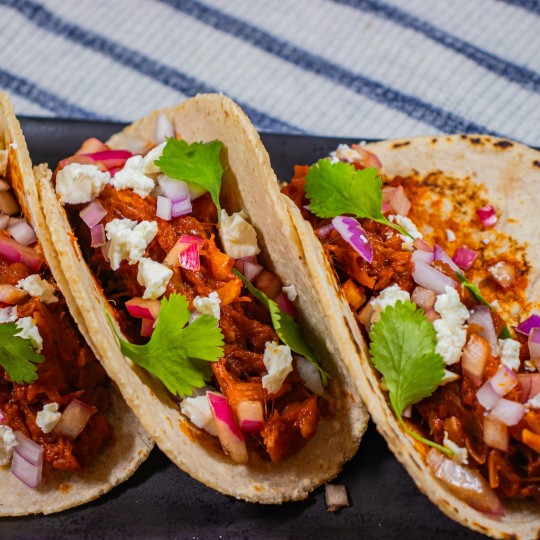
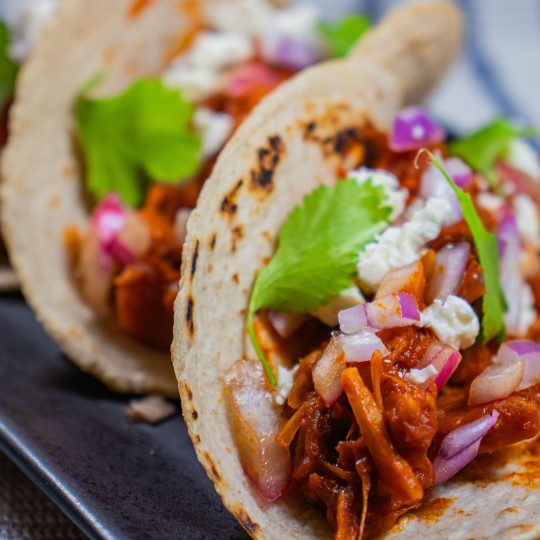
The only things I'd recommend are:
1. Make sure to knead each portion of tortilla "dough" until they are properly smooth, it will make sure you get a smooth outside to the tortillas and prevent them cracking. This will take maybe 1 minute for each one. I just kept squishing it in my hand and then rolled it into a ball.
2. If, like me, you don't have a tortilla press, you can place the balls between parchment paper and then put it on the floor with a flat board above and then gently step on the board. I ended up on one leg with my entire body weight on the board and then gave them a little roll with a rolling pin just to even put the shape if necessary.
3. Trust Sialia's process. They need to stand, covered, to soften and I promise they will - just don't be worried if it takes a little longer than you expect. I piled them all up under a bowl and once a few were there and steaming, they softened much faster.
For anyone interested, the filling is pulled jackfruit and butternut squash in a guajillo and ancho chilli sauce. It's then sprinkled with queso fresco - although pick your fave cheese if you prefer, chopped red onion (purple), red onion soaked in red wine vinegar and sugar - a quick pickled onion (pink), and coriander/cilantro. 10/10 will be making again
#jumblr#jewish food#sialiaskitchen#honestly these are unreal#and the moment there is sauce involved the matzah taste vanishes#they're so soft and yummy#passover#pesach#kosher#kosher for passover#kosher for pesach
273 notes
·
View notes
Text
Passover Banana Chocolate Chip Cake!!!!!
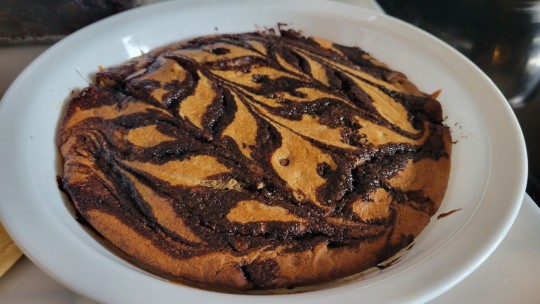
woooooo! It is fluffy and moist and delicious!!!
#food#delicious#kosher#kosher for passover#passover#kosher for pesach#pesach#kosher l'pesach#l"pesach#gebrochts#banana#chocolate#chocolate chip#cake#passover cake#passover desserts
22 notes
·
View notes
Text
Looking for a good Pesadik main dish for whatever point in the holiday? I've got you covered. We use tapioca starch for this, and though in the past we've found Pesadik mock regular mustard, the only one available this year was honey mustard, so we substituted horseradish sauce (chrein). If you go that route, use the white one, not the purple one with beets! You do actually need to roughly measure the zucchini cuz with the suggested 3-4 large zucchinis, you'll end up with way too many zoodles compared to the tuna. We don't usually use the green chilies; that much heat would exacerbate a chronic illness or 2 for me and possibly also not be great for some relatives.
Anyway, this comes out delicious - my brother even remarked that it "has a sort of cheesy mouthfeel" - and is great for feeding people who can't have dairy at a dairy/pareve meal. (*cough* me *cough*) Enjoy!
#zoodles#tuna casserole#food#recipe#tuna zoodle casserole#pesadik food#pesach#kosher for passover#pesach food#passover food#kosher for pesach
5 notes
·
View notes
Text
2 notes
·
View notes
Text
today i learned that there is MATZAH THAT ISN'T KOSHER FOR PASSOVER??? WHY. WHY. IT HAD ONE JOB. I AM LOSING MY MIND. WHO THOUGHT THIS WAS A GOOD IDEA.
#and this is a store that didn't have any matzah the rest of the year but now we're near pesach they get non-kosher matzah???? why??????#jumblr#avi posts#i'm not even fully kosher exactly bc i'm vegan so i never have to think about it but i wanted to try being more specific about it for pesac
468 notes
·
View notes
Text
An Introduction to Kashrut & Kosher Eating

i. "Kashrut" and "Kosher"?
ii. Kashrut Specifics
iii. Modified Ways to Keep Kosher
iv. Resources
border inspo & header art

You may already be confused about what these words even mean, and that's totally okay, we're all here to learn. The following are some important terms to keep in mind:
Halakha : Jewish Law as outlined within the Talmud. It governs everything from punishment for crimes to sex to defining "what" Judaism is. It is more of a way of life than a set of laws.
Kashrut : A subsection of Halakha, specifically referring to regulations surrounding food and everything to do with it.
Kosher : An adjective used to refer to food or food-related products (like forks and spoons) that are deemed okay for Jews to eat/use by Kashrut. "Keeping Kosher" refers to eating according to Kashrut.
Kashering : To cause something to become kosher.
Treif : Everything that is non-Kosher.
Pareve : Food that is "neutral", neither meat nor dairy. This includes fruits, vegetables, grains, eggs, and sometimes fish.
Kashrut tells us what animals are safe to eat, how these animals should be slaughtered, what food can and can't be mixed, alongside instructions on how to use the tools made for preparing/eating food. There's a lot more to Kashrut (which I'll go into soon), but those are the basic ideas. Kashrut includes many guidelines that we see as common sense (such as not eating diseased meat) to everyday cleanliness (checking that fruits and veggies are free of bugs) to things that some people would think are "weird" (like not eating shrimp).
Of course, much of Kashrut is highly cultural in nature, and was largely shaped by Jewish cultural ideas of cleanliness and commonly eaten foods. Some animals may be a normal part of the cultural in many countries/cultures, but they are not Kosher, as Israelites never included such things in its food. This is why many Jews who are also parts of cultures to whom treif foods are significant experience a lot of inner conflictions about keeping Kosher. Instances like the one mentioned before, alongside a countless amount of others, are why there are different levels of keeping Kosher, which I will expand on soon.
Many people ask me why I eat Kosher in the first place. Reactions range anywhere from "Oh wow, I could never give up bacon!" to "Ugh, why follow such archaic laws?" when people find out.
But really, why do we? Is it because it would cause severe health issues if we ate shellfish or a ham and cheese sandwich? No, obviously not. While some of the prohibitions in Kashrut may have health benefits, such as avoiding certain diseases or infections, the primary reason for observing these laws is not based on health concerns. In fact, Halakha dictates that we should not eat Kosher if it would threaten our health or lives in any way. We live by the laws, we don't die by them.
Interestingly enough (right back at ya, "archaic laws" person), it's because they are archaic. It is not because anyone who eats pork is disgusting or wrong or bad in any way. It's our culture, our tradition, it's been passed down for absolutely forever. It's a marker and a reminder of who and what we are, a way to celebrate Jewishness. It's also a ritual, a daily form of active mediation and prayer to bring us closer to (and remind us of) HaShem.
Eating Kosher is not just about what we eat, but also about how we eat. It's a daily ritual that involves mindfulness, intentionality, and gratitude. It's a way to incorporate our culture and religion into our every day, never forgetting who we are. By following these ancient guidelines, we affirm our connection to a long and rich history, to a community that has survived and thrived through centuries of persecution and adversity.
We embrace a way of life that is not driven by the latest trends or fads, but rather by timeless values and principles that have stood the test of time. When we follow the laws of Kashrut, we are reminded of our connection to HaShem, the sanctity of our traditions, and the importance of our community.

Alright, now it's time to get into the exact specifics of what Kashrut outlines for us. It is usually Orthodox Jews who follow every single one of the rules, Conservative Jews follow most(ish) of these rules, and Reform Jews tend to not keep kosher. Of course, this doesn't speak for all denominations or even every Jew in each of the denominations I mentioned, but those are the most common "levels" of keeping kosher among Jews. Keeping kosher is hard, and not everyone has the time, resources, etc. to follow Kashrut as closely as they'd like, which is why different people choose what's right for them.
In this section, I'll cover the exact guidelines in Kashrut, exceptions to keeping kosher, and some modern interpretations of kosher expectations.

Anything produced by forbidden animals- like their eggs and milk- is prohibited.
Land mammals should have cloven hooves and chew their cud.
— In Leviticus 11:3 and Deuteronomy 14:6
— Cloven hooves: Hooves split into two "toes".
— Chewing cud: The process of chewing, partially digesting, regurgitating, and re-chewing food.
— Permitted land mammals include oxen, goats, sheep, and deer.
— Forbidden land mammals include pigs, horses, rabbits, and camels.
Marine life must have fins and scales.
— In Leviticus 11:9 and Deuteronomy 14:9
— Permitted marine life includes salmon, tuna, and carp.
— Forbidden marine life includes shrimp, lobster, and scallops.
Birds must not be scavengers or birds of prey
— In Leviticus 11:13-19 and Deuteronomy 14:11-18
— Only specific birds are prohibited, not types of birds. Rabbis have decided to forbid the categories the listed birds fall into (scavengers and birds of prey).
— Permitted birds include chicken, geese, ducks, and turkeys.
— Forbidden birds include eagles, vultures, ravens, and owls.
Winged insects are… complicated.
— In Leviticus 11:22
— Some winged insects used to be permitted, but we no longer know which ones those are, so all winged insects are decidedly forbidden.
— Interestingly enough, Yemini Jews have very very old traditions of identifying and eating certain locusts as kosher animals. This could be an echo of our now lost outlines on what insects are, in fact, kosher. How cool is that?
Other miscellaneous animals are forbidden.
— In Leviticus 11:29-30, 42-43
— Rodents (mice, squirrels, rats)
— Wingless insects (centipedes, silverfish, lice)
— Amphibians (frogs, toads, salamanders)
— Reptiles (snakes, lizards, turtles)
Certain parts of kosher animals are forbidden to eat.
— All blood from the meat of land mammals and birds must be drained out during slaughter and then salted/broiled out because blood is their life force and should be respected (Leviticus 7:26-27; 17:10-14).
— Fat found on on the internal organs and below the eleventh rib (Leviticus 3:9; 7:23).
— The sciatic nerve (of the lower leg) to commemorate Jacob’s victory over an angel after they wrestled all night, during which the angel dislodged Jacob’s sciatic nerve (Genesis 32:22).
Animals must be slaughtered in a particular way.
— In Deuteronomy 12:21; 14:21 and Numbers 11:22.
— These rules pertain to land mammals and birds, but not fish.
• Animals cannot have died due to natural causes or another animal killing them.
— Meat should not be diseased or flawed in any way.
— Animals must be slaughtered by having their throat slit quickly and in one strong slash. This way, the most blood drains out and the animal is slaughtered in the most humane way.

Meat and dairy cannot mix (Exodus 23:19; 34:26 and Deuteronomy 14:21).
Foods which are neither meat nor dairy are pareve, and can be used freely with both meat and dairy.
— Commonly, fish is counted as pareve, but some traditions (usually Sephardic) prohibit the mixing of fish with meat.
A certain amount of time should pass between the consumption of meat and dairy.
— Traditionally, one waits 3-6 hours after eating meat to consume dairy, but only 1-3 hours after eating dairy to eat meat.
— Some traditions include that one must wait only an hour after dairy, except for hard cheeses, after which they must wait 3 hours.
Different utensils and equipment must be used for meat and dairy. This includes everything from the tools used for slaughter to the plates in your home.
— Utensils have a label just like food (meat, dairy, pareve, or treif) which affects the status of the food which comes in contact with it, but only in the presence of heat.
— For example, a fork will become treif if it touched shrimp, and if it touches any hot kosher food (or if the fork or shrimp is hot), the food also becomes treif. This affects things like dishwashers (in which both meat and dairy utensils come in contact with heat in the same space), sinks (which can be hot), and towels (when used to transport hot pots).
— It is totally fine to do something like use a knife with both meat and dairy, as long as both the knife and food is cold, and as long as the knife is cleaned between foods.

All fruits and vegetables are kosher.
— In Genesis 1:29
— Fruits and vegetables must be thoroughly washed and checked for bugs.
— Fruits and vegetables cannot come in contact with any products which include insects, like some dyes and additives.
Grape products cannot be made by idolators.
— This began because of wine's ritual importance, and Jews did not want to consume wine that was made to use in the worship of idols.
— This usually only refers to wine or grape juice.
— More recently, because the creation of wine is now automated, it is technically not made by idolators and has been seen as kosher to some denominations (usually Conservative Jews).

We've gone through the different rules and regulations of Kashrut, which include that utensils/towels can become treif. But what happens if you accidentally eat treif? If utensils become treif, do they need to be thrown out?
Accidentally (or knowingly) eating treif.
— The remedy for this is simply to feel bad and do better in the future.
— But, if you feel particularly bad, you can do a good thing so that the bad thing (eating treif) leads to a good thing, and therefore the entire mistake becomes positive. Good things can include tzedakah, charitable giving (like donating money/old clothes, volunteering, etc.).
Kashering utensils, equipment, etc.
— Kashering is done both when something is first bought and if it ever becomes trief. Usually, only new cooking equipment is kashered (like by being dipped into a mikveh, a pool of holy water), and not everything you buy.
— To "reset" utensils/equipment after it has become treif, it can be dipped in a mikveh, or things like towels can be kashered simply but putting them in the laundry.
— Everyone will have different ways to kasher and different intensities of kashering.
Treif food being the only option.
— During medical emergencies (like a blood sugar crash) or similar situations, it is not a sin to eat treif. Human life is put above all else within Judaism, meaning that everything will be rendered not a sin if breaking it is necessary to save a life (which is also why abortion is required even in the most Orthodox communities).

Keeping kosher is hard. There's a ton of rules and things which build upon each other. It's a lot to remember. Considering that many households separate meat and dairy to the point of having separate sinks and refrigerators, most people just don't have the resources to keep kosher in that way.
If you're low on spoons, disabled, or neurodivergent, those factors can make keeping kosher even more difficult. I'm a spoonie with ADHD and Autism, so I'm chronically fatigued, and have ARFID that contributes to multiple food-related issues.
You should always remember that you are not required to keep kosher if it interferes with medical needs (like I listed), and so you should never feel bad about how "well" you keep kosher. That being said, let's move onto some tips for modified kosher eating.
Try only keeping kosher on shabbat and/or important holidays.
Sometimes, our safe foods or the only food we have access to are treif. However, you're usually already listening to 99% of Kashrut prohibitions on which animals you can eat (like avoiding bugs, reptilians, rodents, scavengers, etc.). So that's already a big step!
Instead of having completely separate equipment for meat/dairy, simply wash your utensils between using them for meat/dairy.
Instead of waiting up to 6 hours between eating meat and dairy, wait 1 hour, drink water between the two foods, and/or create a distinct separation in time between consuming the foods (like getting up to go do something, stopping to talk, etc.).
When it comes to washing utensils, try and separate them by putting them on different washing machine racks, run the washing machine between using it for meat/dairy utensils, or rinse off the inside of the sink between hand-washing meat/dairy utensils.
Use disposable plates/cups/utensils to separate meat and dairy.
Buy only kosher meat, or only kosher foods (most foods in everyday grocery stores will be kosher).
If you're vegan, and depending on the type of vegetarian, you're already eating kosher!

You've finally reached the end of this post, and I hope it was helpful to you. Below, I will list multiple sources for further reading, help in keeping kosher, and just some cool questions about being kosher ("is meat from a cloned animal kosher?").
An extensive course on the laws of Kashrut taught by Rabbis
"Bagels: A Surprising Jewish History" by Dr. Yvette Alt Miller
"Does G-d Really Care?" from Kosher Certification
"I Keep Kosher. My Parents Did, Now Don't. It's Complicated." by Talia Kaplan
"Is Lab-Grown Meat Kosher?" by Yehuda Shurpin
"Issues in Jewish Ethics: The Ethics of [Kosher] Cloning" by Dr. Daniel Eisenberg, M.D.
"Jews in America: The Kosher Meat Boycott of 1902" by Dr. Michael Feldberg
"Kashrut Laws as Written in Torah" from the Jewish Museum in London
"Kashrut: the Jewish Dietary Laws [from Biblical, Rabbinic, and Modern Perspectives]" by Jonathan Magonet
"Marijuana Is Always Kosher, as Long as You Smoke It" by Ruth Schuster
"OU Kosher Grocery Store Symbols Explained" by Rabbi Chaim Goldberg
"People Eat Treyf for Their Own Reasons. They All Think About Their Judaism." by Jonathan Katz
"Saying Goodbye to Bacon" by Liel Leibovtiz
"Ten Reasons to Keep Kosher (And They’re Not What You Think)" by Rabbi Alec Goldstein
"The Jewish Dietary Laws: Their Meaning for our Time and a Guide to Observance" by Samuel H. Dresner and Seymour Siegel
"The Rules for Kosher Creepy-Crawlies" from Sefaria
"What Archaeology Tells Us About the Ancient History of Eating Kosher" by Lina Zeldovich
"What Is Kosher for Passover?" from Chabad.org
"Why I Don’t Keep Kosher" by Rabbi Jillian Cameron
"Why I Stopped Freaking Out About Other People’s Kosher Habits" by Erris Langer Klapper
"Why Keep Kosher?: Jewish dietary practices allow us to welcome the sacred into our daily lives and into mundane acts." by Rabbi Dr. Bradley Shavit Artson
"5 Misconceptions About Keeping Kosher" by Mandy Hakimi

#judaism#jewish#jumblr#jewblr#jewish culture#pesach#passover#kosher#kashrut#torah#talmud#shabbat#jewish life#kosher food#halakha#yeshivawithcarver#references
432 notes
·
View notes
Text
recipes i'm going to make this pesach:
sweet & sour braised roast (i've a kalakel cut so that is what i'll be using)
olive oil mashed potatoes
apple matzah kugel
... and the leftovers on these will keep us fed the whole time, basically, as it's just my partner + me. but i'm also planning to make
matzah "chilquiles" one day for breakfast :)
and moroccan paprika fish because i cherish my once a week fish allowance during pregnancy like nothing else.
42 notes
·
View notes
Note
Tw: the holocaust, mentions of the current war, bad spelling/grammar, trauma dumping (I’m sorry)
Jewish culture (with parents from Russia/Ukraine) is growing up with stories of antisemitism from your family, growing up being told/thinking you were safe in the US, only to be proven wrong again and again and again
Jewish culture is being one of two Jewish kids in your middle school, when your teacher decides that ‘boy in the striped pajamas’ is a good source to use to teach the holocaust (and then vaguely bonding with the other Jewish kid over history class, because even though you’ve only spoken like 5 times before that, the constant camping out in the bathroom with nothing to do facilitated a mutual kindness and respect)
Jewish culture is having to explain why you can’t have pizza or breadsticks during Passover every year
Jewish culture is being happy every time a new friend asks about your dietary restrictions, because even though they know you’re Jewish, they don’t really know what that means, but they want to. Because they care about you.
Jewish culture is seeing ‘protesters’ with anti-Israel and holocaust denial signs outside your synagogue every week for years, even before the current war (and then being told that it’s free speech when it’s brought up to city council)
Jewish culture is being proud of your Jewishnis, and then being told by your parents that you have to hide it, for your own safety.
Jewish culture is being happy any time your friends remember your dietary restrictions, or holidays, or stand up for you
Jewish culture is wanting to wear heels to synagogue, but also worrying in that back of your mind that you can’t run in heels very well
Jewish culture is loving the massive Minora(?) your synagogue lights up outside every year, but also checking behind you every few seconds to make sure everyone is safe
Jewish culture is not knowing how the F to spell any Jewish words (holidays, places, objects, food, ect.) because each one has like 17 different spellings, and you’re dyslexic, so you just throw letters on a page and hope autocorrect understands (it doesn’t)
Jewish culture is finding this blog and being so happy you almost cry 💙
we love you here, don't worry!! your grammar was perfect and your spelling wasn't too bad, just two words I noticed! (jewishness and menorah). I am so glad you found my blog, I am so glad I made this blog. every time I get a long ask like this, I almost light up with joy because it makes me so happy to know people feel safe to submit their stories like this, so thank you too!! <33
also don't worry, nobody knows how to spell a lot of the words, as long as the sounds are close enough we'll understand!!
#jewish culture is#judaism#jewish#jumblr#antisemitism#holocaust#shoah#shoah mention#tw shoah#kosher#chanukah#hanukkah#pesach#passover
42 notes
·
View notes
Text
As someone who is very allergic to both gluten and dairy I love Pesach bc it’s the one time a year everyone has to eat like me
#shoutout to kosher for pesach desserts in the grocery store#I will in fact miss you#jumblr#judaism#jew by choice#jewish#jewish stuff
82 notes
·
View notes
Text
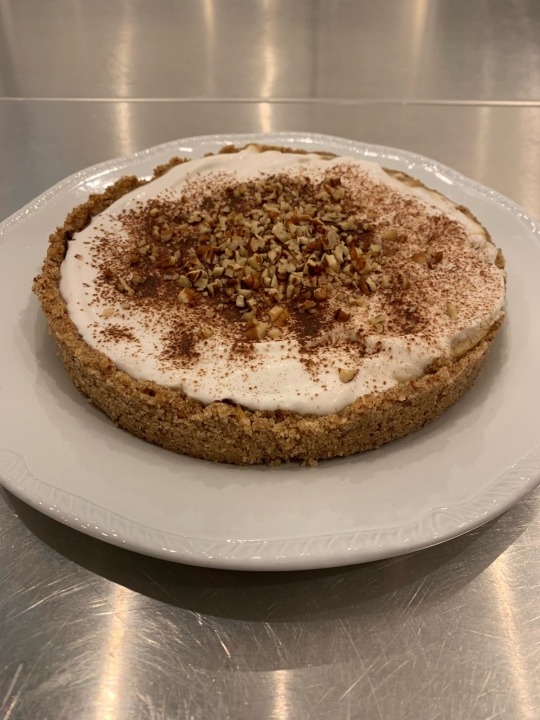
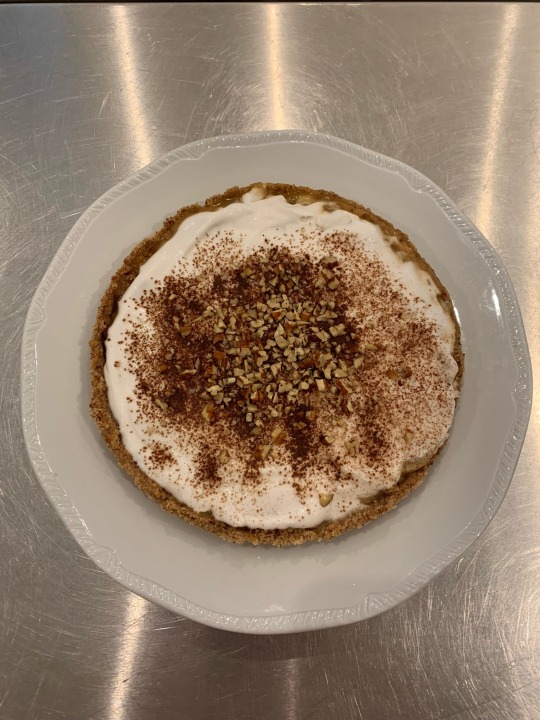

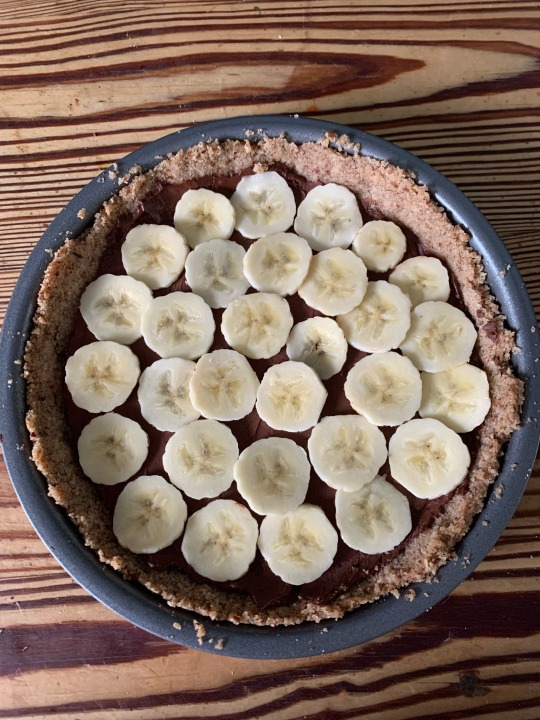


Vegan Passover Pecan-Banoffee Pie: my magnum opus
I set out with a dream. An impossible dream. To create a vegan dessert for my synagogue seder that was also kitniyot-free. Did I have to do this? Not really, my shul allows anything vegan, vegetarian or pescatarian that doesn’t have chametz, and we have a section for kitniyot. Am I vegan? No. Do I even keep kosher for Passover myself? Also no. But, you see, I have an almost pathological need to feed as many people as possible, and I am intractably stubborn, so once I realised how difficult this was going to be it only made me dig my heels in further.
It turns out to be borderline impossible to find vegan substitutes for pretty much anything that don’t contain soy, oats, cornflour, chickpeas, or some sort of forbidden legume. Subsequently this recipe is heavily reliant on coconut milk; luckily for me I live in an area with a large Muslim population and it’s currently Ramadan, so tins of coconut are front and centre of every supermarket display.
It’s taken almost a full month of trial, error and meltdowns in the butter aisle of Sainsbury’s, but I finally did it. I had to cobble bits of the recipe together from half a dozen different sources, so I feel relatively justified in calling this my own invention. The pecan crust is borrowed from a Tori Avey cheesecake recipe, I just swapped pistachios for pecans. I really think the crust is what makes it, to be honest. You could probably skip the ganache layer if you can’t be bothered, I just feel like it helps cut through the sweetness.
Recipe under the cut. Please please tag me if anyone decides to make this! I would be so delighted to see it out there in the world.
Crust
84g (⅔ cup) pecans
84g (⅔ cup) pecans
84g (⅔ cup) pecans
60g (½ cup) matzo meal
66g (⅓ cup) granulated sugar
71g (5 tbsp) Kosher for Passover vegan margarine (Rakusen’s Tomor*), melted, + extra for greasing
Pinch of salt (optional)
Ganache
113g KFP vegan dark chocolate (Lindt Excellence 70%, Green & Black’s 70%, Green & Black’s cooking chocolate are all KFP)
113g coconut cream/full-fat coconut milk
A few drops of vanilla extract (optional)
Caramel
200g caster sugar
100g KFP vegan margarine (Tomor)
200g coconut cream/full-fat coconut milk
Whipped cream
200g coconut cream/full fat coconut milk, kept in the fridge overnight
15-45g KFP icing sugar (check it doesn’t contain maize starch. You could probably omit the sugar and leave the cream unsweetened if you can’t find it, or grind your own- there are recipes for Passover powdered sugar online.)
¼ tsp vanilla extract
3-4 bananas
cocoa powder or grated chocolate to serve (optional)
chopped pecans to serve (optional)
Method
Make the caramel. Place the sugar into a medium / large saucepan. Place the pan on the hob over a low heat. Allow the sugar to melt, this will take around 5-8 minutes. Don’t burn the sugar! Make sure to stir constantly to prevent burning. You can use a wooden spoon or heat proof spatula.
When all of the sugar has melted and is a golden / amber colour, add in the margarine. Be careful, as the sugar is very hot. Remove the pan from the heat and stir to combine. Allow the margarine to melt into the sugar. It might bubble but that's fine. Once it’s combined, it might have a thick consistency. It might look like the margarine isn’t mixing with the sugar, but it should combine once you add the cream. Now add in 200g coconut cream. It will steam and bubble again so be careful.
Add the pan on the heat and allow to simmer for 3-5 minutes to help thicken it up.
Remove the pan from the heat. Set aside to cool for 30 minutes, then transfer / pour the caramel into a heat proof jar. Place the jar into the fridge. Allow to chill overnight. The coconut cream for the whipped cream should also be kept in the fridge overnight, to encourage it to separate and firm up.
If the caramel separates overnight, use an electric whisk to combine into a smooth consistency until there are no remaining lumps. It’ll be a more custard-like texture but still delicious. Keep caramel in the fridge until needed.
Make the crust. Preheat oven to 180˚C. Grease a loose-bottomed tin with margarine and line with greaseproof paper.
Blitz the pecans in the food processor until finely processed. Add matzo meal, salt and sugar and pulse until the entire crust is uniform in colour. With the processor on, drizzle the melted butter into the machine.
Once all the butter has been added, turn the processor off and dump the wet crumbs into the bottom of the lined pan. Using the back of a spoon, press the crumbs evenly into the bottom and up the sides of the pan (it doesn’t have to go all the way up, just as much as you can).
Place the crust in the oven for 8-10 minutes, or until the edges of the crust start to brown a bit and smells fragrant. Leave crust to cool for about ten minutes and then transfer to the fridge to finish cooling.
Make the ganache. Finely chop the chocolate and put in a medium-sized bowl. Put 200g coconut cream in a microwave-safe bowl and heat in the microwave for about 1 minute, watching to make sure it doesn’t bubble over.
Pour the warm cream over the chocolate chips and let sit for 2-3 minutes. Don't stir yet.
After 2-3 minutes, whisk the chocolate/melted coconut milk until smooth. Add vanilla if desired. Let cool in the fridge for around 30 minutes.
Make the whipped coconut cream. Chill a mixing bowl in the fridge for ten minutes (you can do this while the ganache is cooling to save time). Put 200g coconut cream (the thick white part, not the clear liquid) in the chilled bowl. Beat for 30 seconds with an electric whisk until creamy. Add vanilla and icing sugar and mix until creamy and smooth – about 1 minute. Avoid overwhipping because it can cause separation. Taste and adjust sweetness as needed.
Carefully run a knife around the edge of the crust tin and remove the crust from the tin.
Spread a layer of the cooled ganache over the bottom of the crust. Top with a layer of sliced banana and return to the fridge to set for ten minutes.
Add a layer of the caramel, another layer of sliced banana, and return to the fridge for ten minutes again.
Top with the whipped cream (I like to leave the edge of the bananas visible around the edge). Dust with cocoa powder or grated chocolate and add chopped pecans if desired.
*Tomor contains sunflower oil, but sunflower oil is not considered kitniyot in England: https://www.kosher.org.uk/article/sunflower-oil-kitniyot
#Passover recipe#pesach 5783#pesach 2023#pesach recipe#passover#Passover 5783#Passover 2023#Passover food#pesach food#פסח 5783#פסח#פסח שמח#jumblr#judaism#jewish#jewish food#kosher#kosher food#kashrut
76 notes
·
View notes
Text
I have an announcement for the Jews In My Phone:
I am no longer feeding you challah, I am now feeding you cremslach

Chag sameach and have a lovely Pesach xoxo
126 notes
·
View notes
Text
Passover Pierogies, my mutuals.
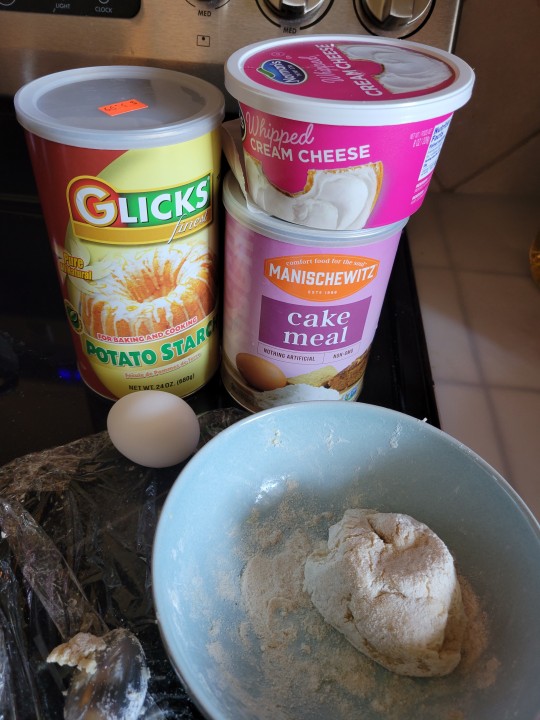
3 parts cake meal to 1 part potato starch, mix in enough cream cheese to make a crumbly paste, stir in 1 beaten egg and then knead. Add a drizzle of water if needed to make a smooth soft dough. Knead smooth.

Break off a walnut sized ball, roll smooth, dust with cake meal mash flat between two pieces of plastic wrap.
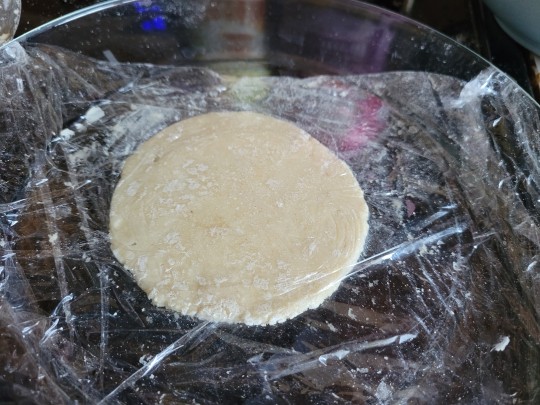
Add an oblong of well seasoned mashed potatoes

fold over and crimp to seal
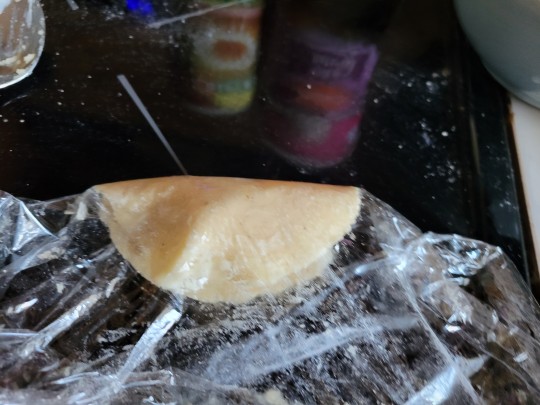
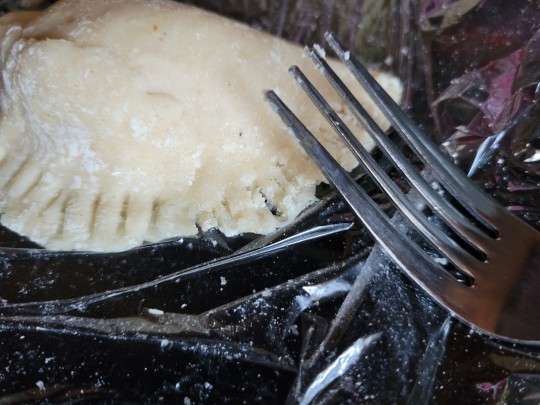
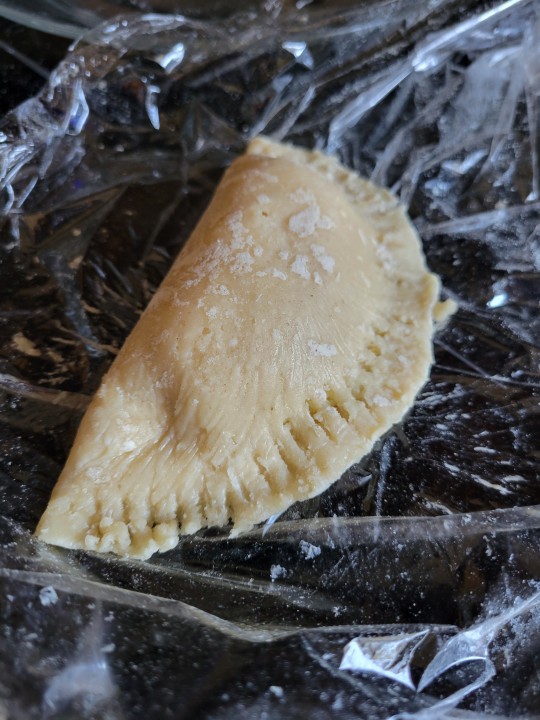
Simmer very gently, 3 minutes, with lid on so steam is trapped. Stir gently to make sure they aren't stuck to the pot . don't crowd the pot. When they float, they are done.
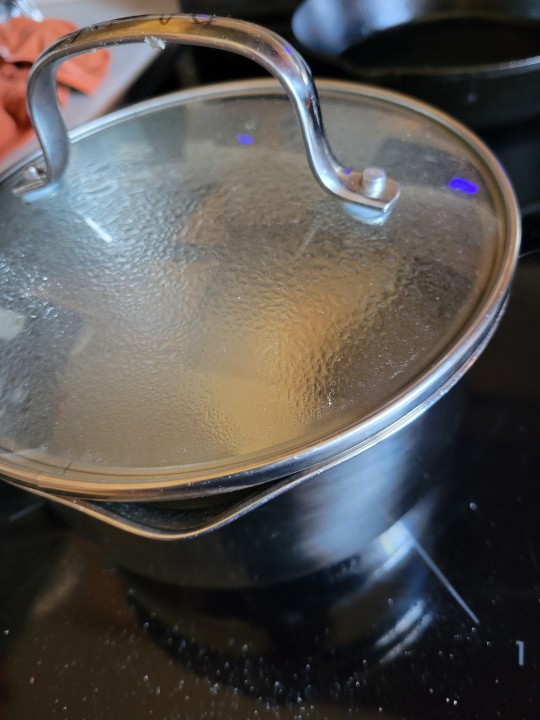
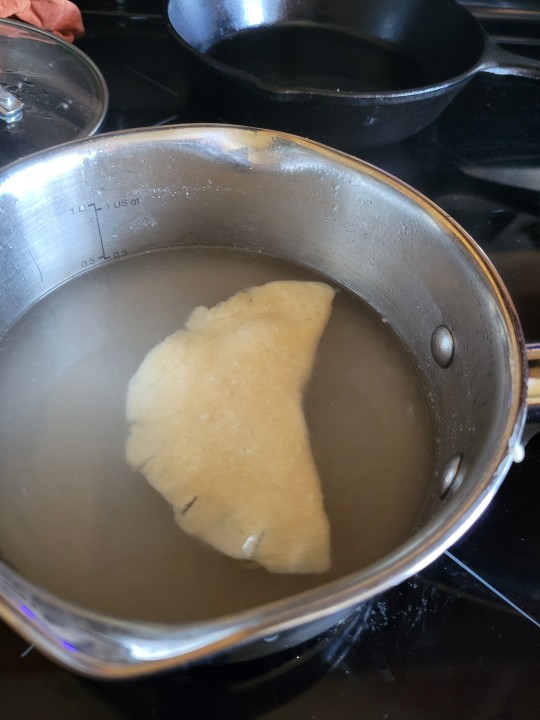

You are welcome.
2 notes
·
View notes
Text
And what would Pesach be without quinoa side salads? We use spinach instead of kale for this easy, delicious family favorite. You could use it as a main, but you'd definitely want something else nutrient-dense to go with it; it's just too light to be the lone entree of a major meal.
#quinoa#quinoa recipe#quinoa salad#quick and easy#kosher for pesach#pesach food#pesadik food#pesach#passover#kosher for passover#passover food#recipe#food#side dish
0 notes
Text
better make sure cum is kosher for passover
72 notes
·
View notes
Text

חַג פֶּסַח שָׂמֵחַ וְכָשֵׁר עֲדַת יִשְׂרָאֵל
וּשְׁמַרְתֶּם אֶת-הַיּוֹם הַזֶּה, לְדֹרֹתֵיכֶם--חֻקַּת עוֹלָם.🤍✨ אָמֵן
Chag Sameach and a Happy Kosher Holiday.
Wishing Holy Graceful Passover Blessings.
May the sweet rays of togetherness shimmer love, joy, and faith.
May the enduring beams of liberty, freedom and salvation bless us all.
Amen.
9 notes
·
View notes
Text
here's some Jewish joy for y'all!
a while back, i had an interesting conversation with some friends about the kosher status of honey. like, it's obviously kosher, given, yknow, Rosh HaShana, but we were debating its kosher status anyways. turns out there is a specific part of the Gemara that states that, because honey is not in itself a secretion of the bee, and since it comes from kosher nectar, it is kosher, which we found interesting!
now I'm thinking, given that peas are considered kitniyot, and they can flower, would a hypothetical pea-based honey be permissible during pesach?
44 notes
·
View notes